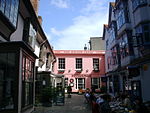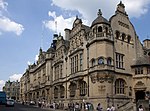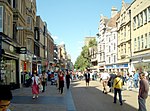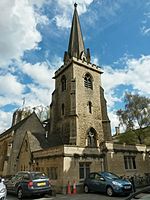The St Scholastica Day riot took place in Oxford, England, on 10 February 1355, Saint Scholastica's Day. The disturbance began when two students from the University of Oxford complained about the quality of wine served to them in the Swindlestock Tavern, which stood on Carfax, in the centre of the town. The students quarrelled with the taverner; the argument quickly escalated to blows. The inn's customers joined in on both sides, and the resulting melee turned into a riot. The violence started by the bar brawl continued over three days, with armed gangs coming in from the countryside to assist the townspeople. University halls and students' accommodation were raided and the inhabitants murdered; there were some reports of clerics being scalped. Around 30 townsfolk were killed, as were up to 63 members of the university.
Violent disagreements between townspeople and students had arisen several times previously, and 12 of the 29 coroners' courts held in Oxford between 1297 and 1322 concerned murders by students. The University of Cambridge was established in 1209 by scholars who left Oxford following the lynching of two students by the town's citizens.
King Edward III sent judges to the town with commissions of oyer and terminer to determine what had gone on and to advise what steps should be taken. He came down on the side of the university authorities, who were given additional powers and responsibilities to the disadvantage of the town's authorities. The town was fined 500 marks and its mayor and bailiffs were sent to the Marshalsea prison in London. John Gynwell, the Bishop of Lincoln, imposed an interdict on the town for one year, which banned all religious practices, including services (except on key feast days), burials and marriages; only baptisms of young children were allowed.
An annual penance was imposed on the town: each year, on St Scholastica's Day, the mayor, bailiffs and sixty townspeople were to attend a Mass at the University Church of St Mary the Virgin for those killed; the town was also made to pay the university a fine of one penny for each scholar killed. The practice was dropped in 1825; in 1955—the 600th anniversary of the riots—in an act of conciliation the mayor was given an honorary degree and the vice-chancellor was made an honorary freeman of the city.











